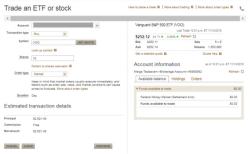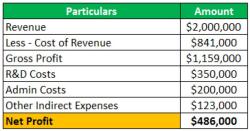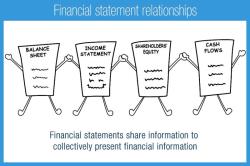What are the basic accounting formulas?
Basic accounting formulas are fundamental equations used in accounting to track and analyze a company's financial transactions. These formulas provide insights into a company's financial health, performance, and various aspects of its operations. Here are some of the most essential accounting formulas that every business should know:
The Accounting Equation:
- Assets = Liabilities + EquityThis equation represents the fundamental accounting relationship. It states that a company's assets are funded by a combination of liabilities and owner's equity.
Revenue:
- Revenue = Sales, Fees, or Other IncomeThis formula represents the total income generated by a company from its primary operations.
Expenses:
- Expenses = Costs, Overheads, or Other ExpendituresExpenses are the costs incurred in the process of generating revenue. The difference between revenue and expenses is the company's profit.
Net Income (Profit):
- Net Income = Revenue - ExpensesNet income is the amount of profit earned by a company after deducting all expenses from its total revenue.
Gross Profit:
- Gross Profit = Revenue - Cost of Goods Sold (COGS)Gross profit represents the profit a company earns from its core business activities before deducting operating expenses.
Operating Income:
- Operating Income = Gross Profit - Operating ExpensesOperating income shows the profit generated from a company's normal operations after subtracting operating expenses.
Net Profit Margin:
- Net Profit Margin = (Net Income / Revenue) x 100Net profit margin is expressed as a percentage and shows the portion of revenue that becomes profit after all expenses.
Return on Assets (ROA):
- ROA = (Net Income / Total Assets) x 100ROA measures a company's ability to generate profit from its assets.
Return on Equity (ROE):
- ROE = (Net Income / Owner's Equity) x 100ROE indicates the return earned on the owner's equity investment.
Current Ratio:
- Current Ratio = Current Assets / Current LiabilitiesThe current ratio assesses a company's short-term liquidity and its ability to meet its short-term obligations.
Quick Ratio (Acid-Test Ratio):
- Quick Ratio = (Current Assets - Inventory) / Current LiabilitiesThe quick ratio is a more stringent measure of liquidity that excludes inventory.
Debt to Equity Ratio:
- Debt to Equity Ratio = Total Debt / Owner's EquityThis ratio shows the proportion of a company's financing that comes from debt as opposed to equity.
These basic accounting formulas provide a foundation for understanding a company's financial position, profitability, and operational efficiency. They are used by businesses to prepare financial statements, assess performance, and make informed financial decisions.
Basic Accounting Formulas: Understanding Financial Equations
Accounting formulas are mathematical equations used to calculate a company's financial performance. They are used to generate financial statements, such as the income statement, balance sheet, and cash flow statement. Accounting formulas are also used to calculate various financial ratios, which can be used to assess a company's financial health and profitability.
Key Formulas for Calculating Financial Performance
Some of the most common key formulas for calculating financial performance include:
- Revenue: Revenue is the total amount of money generated by a company from sales of goods or services. It is calculated using the following formula:
Revenue = Quantity sold * Price per unit
- Cost of goods sold (COGS): COGS is the direct cost of producing the goods or services that a company sells. It is calculated using the following formula:
COGS = Opening inventory + Purchases - Closing inventory
- Gross profit: Gross profit is the difference between revenue and COGS. It is calculated using the following formula:
Gross profit = Revenue - COGS
- Operating expenses: Operating expenses are the costs that a company incurs to run its business, such as rent, salaries, and marketing expenses. They are calculated using the following formula:
Operating expenses = Selling and marketing expenses + General and administrative expenses
- Net income: Net income is the profit that a company makes after all expenses have been paid. It is calculated using the following formula:
Net income = Gross profit - Operating expenses - Taxes
Income Statement, Balance Sheet, and Cash Flow Formulas
The income statement, balance sheet, and cash flow statement are the three main financial statements that a company produces. Each statement is prepared using a specific set of formulas.
Income statement formulas: The income statement shows a company's revenue and expenses over a period of time. Some of the most common income statement formulas include:
- Revenue
- COGS
- Gross profit
- Operating expenses
- Net income
Balance sheet formulas: The balance sheet shows a company's assets, liabilities, and equity at a specific point in time. Some of the most common balance sheet formulas include:
- Assets = Liabilities + Equity
- Current assets
- Non-current assets
- Current liabilities
- Non-current liabilities
- Equity
Cash flow statement formulas: The cash flow statement shows a company's cash inflows and outflows over a period of time. Some of the most common cash flow statement formulas include:
- Operating activities cash flow
- Investing activities cash flow
- Financing activities cash flow
- Net change in cash
Practical Applications of Accounting Formulas
Accounting formulas can be used for a variety of practical purposes, such as:
- Financial reporting: Accounting formulas are used to generate financial statements, which are used to report a company's financial performance to investors, creditors, and other stakeholders.
- Financial analysis: Accounting formulas can be used to calculate financial ratios, which can be used to assess a company's financial health and profitability.
- Budgeting and forecasting: Accounting formulas can be used to create budgets and forecasts, which can help companies to plan for the future.
- Decision-making: Accounting formulas can be used to make informed decisions about investments, pricing, and other business matters.
Using Formulas for Financial Analysis and Decision-Making
Accounting formulas can be used to perform a variety of financial analysis and decision-making tasks, such as:
- Assessing a company's financial health: Accounting ratios can be used to assess a company's liquidity, profitability, efficiency, and solvency. This information can be used to identify potential problems early on and to make informed investment and credit decisions.
- Evaluating a company's performance: Accounting ratios can be used to evaluate a company's performance over time and to compare its performance to that of its peers. This information can be used to identify trends and to identify areas where improvement is needed.
- Making investment decisions: Accounting ratios can be used to screen for potential investment opportunities and to evaluate the performance of existing investments. For example, investors may use financial ratios to identify companies with strong growth potential or to identify companies that are undervalued.
- Making pricing decisions: Accounting formulas can be used to calculate the cost of producing goods or services and to set prices accordingly. This information can help companies to ensure that they are making a profit on their sales.
Accounting formulas are an essential tool for financial analysis and decision-making. By understanding and applying accounting formulas effectively, investors, creditors, and managers can make more informed decisions.













